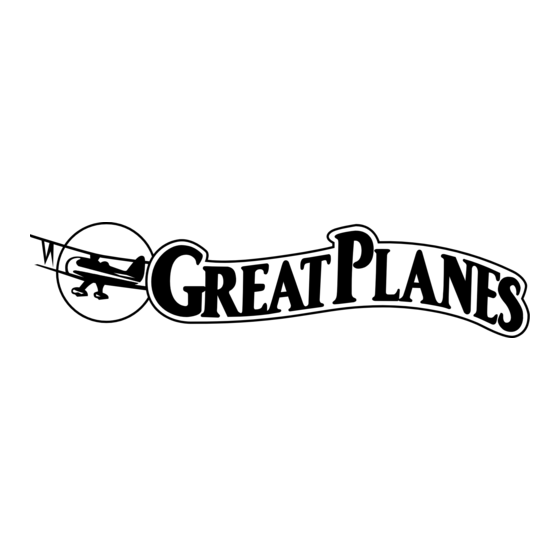GREAT PLANES Wright Flyer Руководство по эксплуатации - Страница 14
Просмотреть онлайн или скачать pdf Руководство по эксплуатации для Игрушка GREAT PLANES Wright Flyer. GREAT PLANES Wright Flyer 16 страниц. Almost ready to fly electric powered r/c airplane

Motor Safety Precautions
Failure to follow these safety precautions may result
in severe injury to yourself and others.
Get help from an experienced pilot when learning to
operate motors.
Use safety glasses when running motors.
Do not run the motors in an area of loose gravel or sand; the
propellers may throw such material in your face or eyes.
Keep your face and body as well as all spectators away from
the plane of rotation of the propellers as you start and run
the motors.
Keep these items away from the props: loose clothing, shirt
sleeves, ties, scarfs, long hair or loose objects such as
pencils or screwdrivers that may fall out of shirt or jacket
pockets into the props.
The electric motors and motor battery used in the Wright
Flyer are powerful and the spinning propellers have a lot of
momentum; therefore, if you touch a propeller while it is
spinning it may inflict severe injury. Respect the motors and
propellers for the damage they are capable of and take
whatever precautions are necessary to avoid injury. Always
disconnect and remove the motor battery until you are ready
to fly again and always make sure the switches are turned
off before connecting the battery.
AMA SAFETY CODE (excerpt)
Read and abide by the following Academy of Model
Aeronautics Official Safety Code:
GENERAL
1. I will not fly my model aircraft in sanctioned events, air
shows, or model flying demonstrations until it has been
proven to be airworthy by having been previously
successfully flight tested.
2. I will not fly my model aircraft higher than approximately
400 feet within 3 miles of an airport without notifying the
airport operator. I will give right of way to, and avoid flying in
the proximity of full-scale aircraft. Where necessary an
observer shall be used to supervise flying to avoid having
models fly in the proximity of full-scale aircraft.
3. Where established, I will abide by the safety rules for the
flying site I use, and I will not willfully and deliberately fly my
models in a careless, reckless and/or dangerous manner.
7. I will not fly my model unless it is identified with my name
and address or AMA number, on or in the model.
9. I will not operate models with pyrotechnics (any device
that explodes, burns, or propels a projectile of any kind).
RADIO CONTROL
1. I will have completed a successful radio equipment ground
check before the first flight of a new or repaired model.
2. I will not fly my model aircraft in the presence of
spectators until I become a qualified flyer, unless assisted
by an experienced helper.
3. I will perform my initial turn after takeoff away from the pit
or spectator areas, and I will not thereafter fly over pit or
spectator areas, unless beyond my control.
4. I will operate my model using only radio control
frequencies currently allowed by the Federal Communications
Commission.
FIND A SAFE PLACE TO FLY
Though the Wright Flyer is a "Park Flyer," the best place to
fly any model is at an AMA chartered club field. Club fields
are set up for R/C flying, making your outing safer and more
enjoyable. We recommend that you join the AMA and a local
club so you can have a safe place to fly and have insurance
to cover you in case of a flying accident. The AMA address
and telephone number are in the front of this manual.
If there is no club or R/C flying field in your area, find a
suitable site that is clear of trees, telephone poles, buildings,
towers, busy streets and other obstacles. Since you are not
flying at a sanctioned AMA site, be aware that there may be
others like yourself who could be flying nearby. If both of
your models happen to be on the same frequency,
interference will likely cause one or both of the models to
crash. An acceptable minimum distance between flying
models is five miles, so keep this in mind when searching for
a flying site.
In addition to obstacles, it is important to be aware of people
who may wander into the area once you begin flying. At
AMA club flying sites it is a severe rule infraction to fly over
others, and this is a good practice if flying elsewhere. R/C
models tend to attract onlookers whose numbers can soon
multiply, forming small, uncontrolled crowds. Onlookers
pose two main problems. First is the danger of actually
crashing your model into a person, causing injury. Second is
the distraction from those who ask you questions while you
are trying to concentrate on flying. To minimize or avoid this
problem, have an assistant standing by who can spot
people who wander into your flying site (so you can avoid
flying over them) and who can perform "crowd control" if
people start to gather.
14
